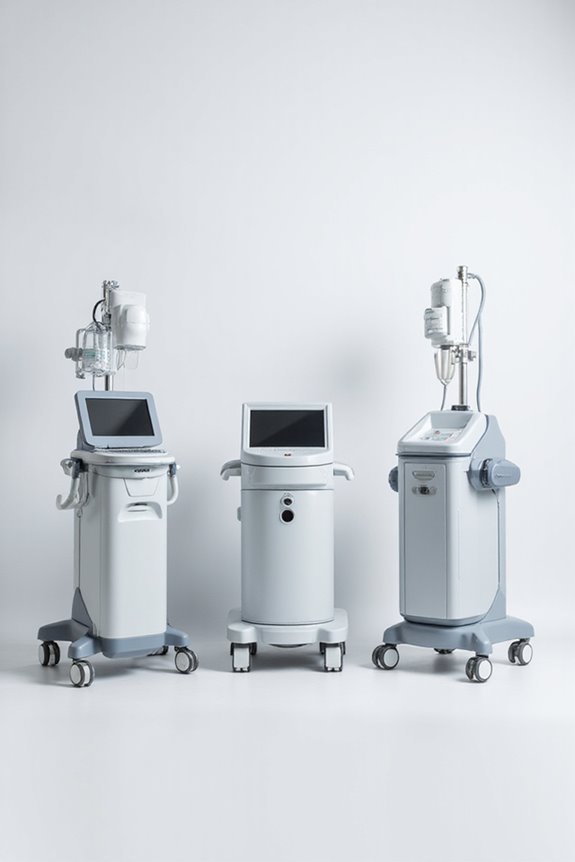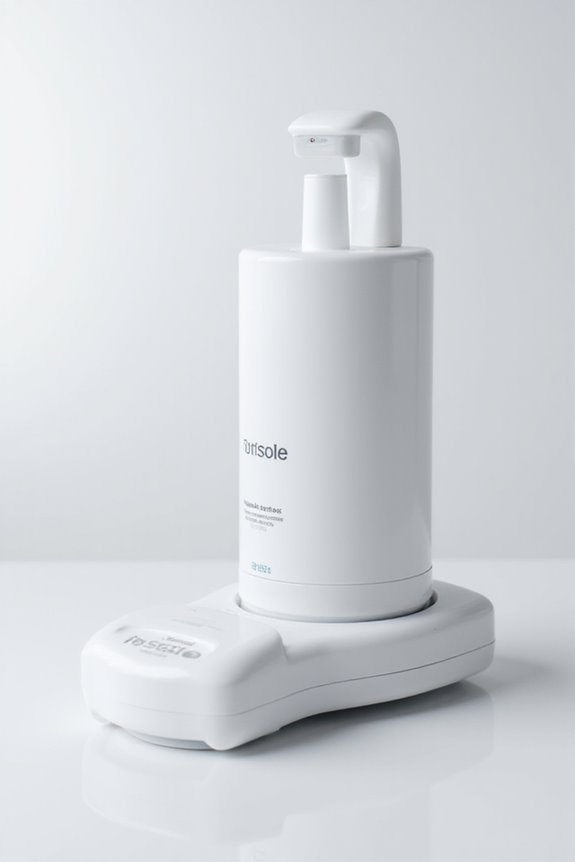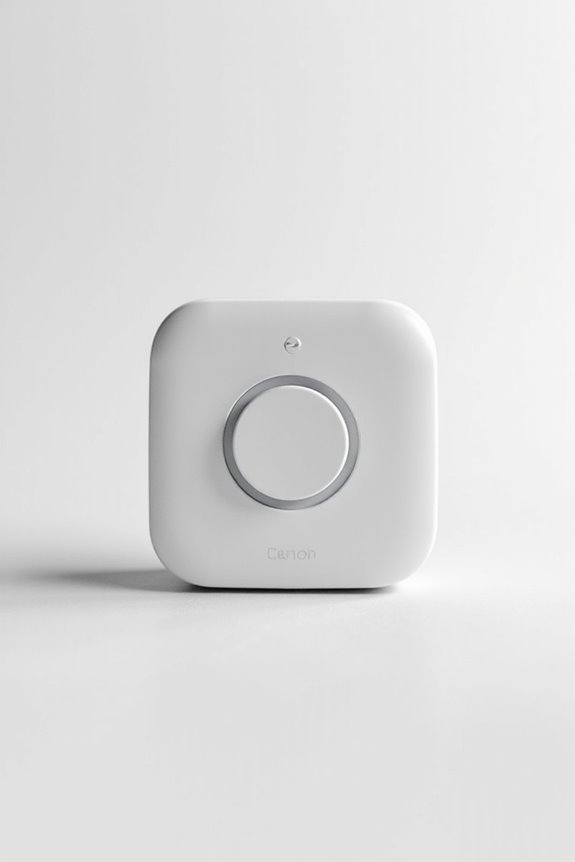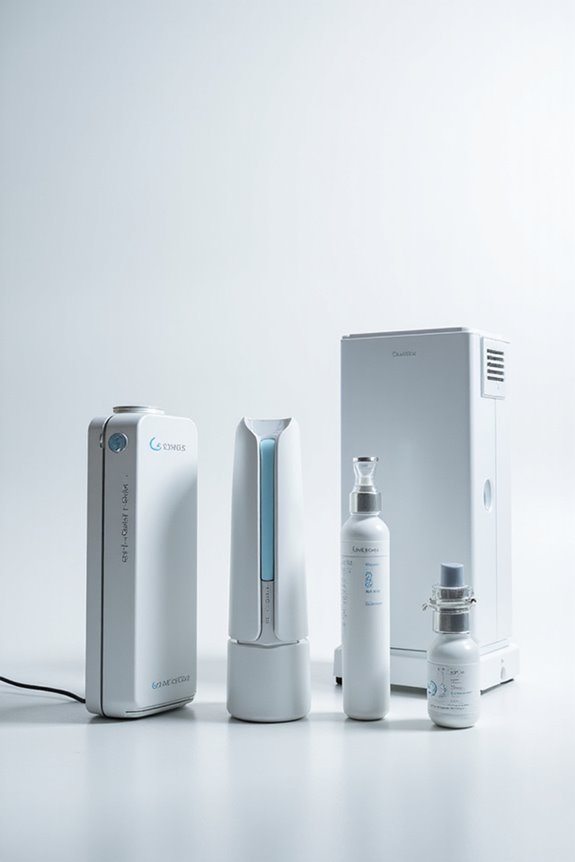Links below are affiliate links. We earn a commission on purchases at no extra cost to you. Although our opinions are based on curated research, we haven't used these products. Articles generated with AI. This article is for informational purposes only and does not constitute medical advice. Please consult a qualified professional for health-related questions.
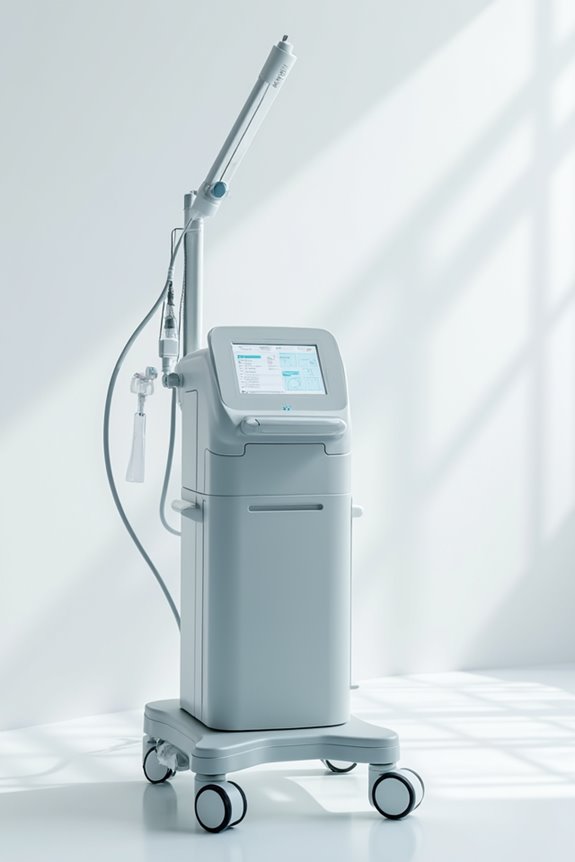
The 5 Best Mobile Oxygen Devices of 2025 – Portable and Life-Changing Solutions
The five best mobile oxygen devices for 2025 include:
- SleepO2 Wrist Pulse Oximeter: Records SpO2 and pulse rate continuously, lightweight at 100 grams.
- Oxygen Concentrator Machine: Adjustable flow, operates quietly at 48 dB, tailored for home use.
- Vibeat OxyU: Bluetooth oximeter with smart notifications and a free management app.
- Wellue O2Ring: Tracks SpO2 and pulse rate; features vibration alerts.
- Portable Oxygen Generator: Adjustable flow from 1-9L, low noise operation.
You’ll find additional details soon.
Key Takeaways
- SleepO2 Wrist Pulse Oximeter: Lightweight, continuously tracks SpO2 and pulse rate for 12 hours, suitable for sleep monitoring with a user-friendly design.
- Vibeat OxyU Wrist Pulse Oximeter: Offers continuous tracking, smart notifications, and a free app for detailed data management, ideal for active users.
- Wellue O2Ring Oxygen Monitor: Provides real-time tracking with vibration alerts for low oxygen or heart rate, perfect for sleep apnea management.
- Oxygen Concentrator Machine for Home Use: Adjustable 1-7L flow rate, low noise operation, and a large LED screen make it convenient for extended use at home.
- Portable Oxygen Generator (1-9L Adjustable): Features low-noise operation, remote control, and easy maintenance; ideal for personalized oxygen therapy.
SleepO2 Wrist Recording Pulse Oximeter by EMAY
Sale
SleepO2 Wrist Recording Pulse Oximeter by EMAY | Continuous Pulse Oximeter to Record Blood Oxygen...
- Most lightweighted wrist pulse oximeter in the market, it weighs only 100 gram that one can sleep with comfortably. Patented silicone soft probe to wear comfortably,...
- Record your blood oxygen saturation (SpO2) & heart rate every second continuously and accurately throughout the night.
- Stand-alone wrist pulse oximeter with built-in recording feature. Just wear it to record overnight, and take it off to sync with app in the morning.
The SleepO2 Wrist Recording Pulse Oximeter by EMAY is an excellent choice for individuals seeking to monitor their sleep quality and oxygen levels effectively. It combines comfort and utility, weighing only 100 grams, making it lightweight for overnight use.
Key Features:
- Continuously records blood oxygen saturation (SpO2) and pulse rate every second.
- Rechargeable lithium battery with a 12-hour life.
- Patented silicone soft probe guarantees a secure fit.
- Stand-alone device with app synchronization for data analysis.
Performance Metrics:
- Rated 4.4 out of 5 stars from 990 reviews.
- Designed for wellness reference, not medical diagnostics.
Best For: Individuals monitoring sleep apnea or those needing to track oxygen levels and pulse rates.
Pros:
- Comfortable and lightweight design, ensuring ease of use overnight.
- Continuous data recording provides valuable insights into sleep quality.
- User-friendly app allows for easy analysis and export of data in various formats.
Cons:
- Some users reported issues with the sensor coming off during sleep.
- Occasional connectivity issues with the app noted by users.
- Not intended for medical or diagnostic purposes, limiting its use for serious health conditions.
Oxygen Concentrator Machine for Home Use
No products found.
Oxygen concentrator machines are ideal for individuals who require reliable oxygen therapy within the comfort of their homes.
Product Overview
- 1-7L oxygen generator designed for home use
- Includes all necessary accessories
Adjustable Oxygen Levels
- Multi-level adjustment: 1-7 levels for stable output
- Timer operation function available
Noise Level
– Operates at a low noise level of 48 dB
User-Friendly Features
– Equipped with a large color LED screen and remote control
Nighttime Use
- Lightweight design for bedside placement
- Continuous operation suitable for nighttime use
Best For: Individuals requiring reliable and adjustable oxygen therapy in the comfort of their home.
Pros:
- Multi-level oxygen adjustment allows for personalized therapy tailored to specific needs.
- Low noise operation ensures uninterrupted use, making it suitable for daytime and nighttime use.
- User-friendly features such as a large color LED screen and remote control simplify operation.
Cons:
- Dependent on electricity, which may limit use during power outages.
- Requires regular maintenance and filter changes to ensure optimal performance.
- Potentially bulky for some bedside tables, depending on available space.
Vibeat OxyU Wrist Pulse Oximeter – Bluetooth Blood Oxygen Monitor with Finger Sensor
Sale
Vibeat OxyU Wrist Pulse Oximeter - Bluetooth Blood Oxygen Monitor with Finger Sensor, Wearable...
- Long-Time Accurate Tracker: OxyU oximeter tracks your blood oxygen saturation level, heart rate and body motion long time, can be used for up to 12-16 hours after fully...
- Detailed APP Records & PC Report: Free to export and share detailed records as PDF, CSV or Binary. View detailed data every four seconds, as well as O2 score. You can...
- Smart Notificarion: Both the device and APP will let you know immediately when your blood oxygen level exceeds the threshold. You can adjust the threshold and intensity...
For individuals engaged in sports and aviation, the Vibeat OxyU Wrist Pulse Oximeter stands out as an ideal choice due to its Bluetooth connectivity and extensive monitoring capabilities.
Key Features:
- Continuous tracking of blood oxygen saturation, heart rate, and body motion for 12-16 hours on a full charge.
- Lightweight silicone ring sensor guarantees comfort during extended use.
- Smart notifications alert users when blood oxygen levels exceed set thresholds.
Data Management:
- Free app enables detailed record management and real-time data viewing every four seconds.
- Stores data and allows exports in PDF, CSV, or Binary formats.
User Experience:
- Automatic activation upon wearing, suitable for all hand sizes.
- High ratings, with 4.6 out of 5 stars based on customer reviews.
Best For: The Vibeat OxyU Wrist Pulse Oximeter is best for athletes and aviation enthusiasts seeking reliable blood oxygen monitoring and heart rate tracking during activities.
Pros:
- Continuous monitoring of blood oxygen saturation and heart rate for up to 16 hours on a single charge.
- Lightweight and comfortable design featuring a silicone ring sensor, making it suitable for extended use.
- User-friendly app for real-time data viewing and easy record management with options for data export.
Cons:
- Some users experience minor issues with Bluetooth connectivity, which may hinder data synchronization.
- The device is not a medical device, thus may not be suitable for individuals requiring clinical monitoring.
- Activation issues have been reported, where the device may not turn on immediately when worn.
Wellue O2Ring Oxygen Monitor with Vibration Reminder
Sale
Wellue O2Ring Oxygen Monitor with Vibration Reminder -Bluetooth O2 Pulse Oximeter Rechargeable,...
- All-day Monitoring: It can be used continuously tracking of blood oxygen level, pulse rate and body motion for the whole day. (Up to 16 hours).
- Smart Readings Reminder: If the O2 level is lower than the preset threshold and heart rate is lower or higher than the preset threshold, the device and the APP will...
- Detailed APP & PC Reports: Free APP & PC software provides graphic O2, PR report and trends of data. Unlimited sharing of PDF and CSV reports. APP compatible with iOS 9.0...
Looking for an effective way to monitor your oxygen levels during the day or night? The Wellue O2Ring Oxygen Monitor offers continuous tracking of SpO2, pulse rate, and body motion.
- Monitoring Duration: Up to 16 hours on a full charge.
- Features: Vibration reminder alerts you when oxygen or heart rate falls below preset thresholds.
- Data Storage: Built-in memory retains four groups of 10-hour data for quick access.
- Compatibility: Pairs with iOS and Android devices for detailed graphical reports.
- User Feedback: Ideal for real-time tracking, especially beneficial for those with sleep apnea.
Best For: Individuals seeking an effective solution to monitor their oxygen levels during sleep or physical activities, especially those with sleep apnea concerns.
Pros:
- Continuous Monitoring: Tracks SpO2 and pulse rates for up to 16 hours with a single charge.
- Vibration Alerts: Notifies users immediately when oxygen or heart rate drops below set levels.
- Comfortable Design: Made with soft silicone, providing a snug fit for fingers between 2-3.2 inches.
Cons:
- Not a Medical Device: Primarily intended for sports and aviation use, not for medical diagnosis.
- Comfort Issues for Larger Hands: Users with larger finger sizes may find the ring uncomfortable.
- Varied Experience with Other Devices: Some users reported frustration with previous pulse oximeters, emphasizing the need for comfort and functionality.
Portable Oxygen Generator (1-9L Adjustable)
No products found.
Portable Oxygen Generators provide a reliable solution for individuals requiring supplemental oxygen therapy, particularly those with chronic respiratory ailments or conditions that necessitate increased oxygen levels.
Product Overview
- Flow range: 1-9L.
- Low noise operation enhances usability.
Control Features
- Two control methods: touch screen and remote control.
- Simple operation, accessible for all users.
Health Benefits
– Improves oxygen supply in the body, aiding health care.
Design and Maintenance
- Easy to clean with flexible air duct.
- Durable cover prevents leakage.
Usability and Comfort
- Portable design facilitates comfortable sleep.
- Smart features minimize user effort and costs.
Best For: Individuals requiring supplemental oxygen therapy due to chronic respiratory conditions or those needing increased oxygen levels.
Pros:
- Low noise operation ensures a peaceful environment for users, particularly during sleep.
- Two control methods (touch screen and remote) provide convenience and accessibility for all users.
- Easy maintenance and cleaning enhance user experience and longevity of the device.
Cons:
- Limited flow range (1-9L) may not meet the needs of all users requiring higher concentrations of oxygen.
- Portability might be compromised for those needing larger, more robust systems for extensive use.
- Initial cost can be a barrier for some individuals seeking affordable supplemental oxygen options.
Factors to Consider When Choosing a Mobile Oxygen Device
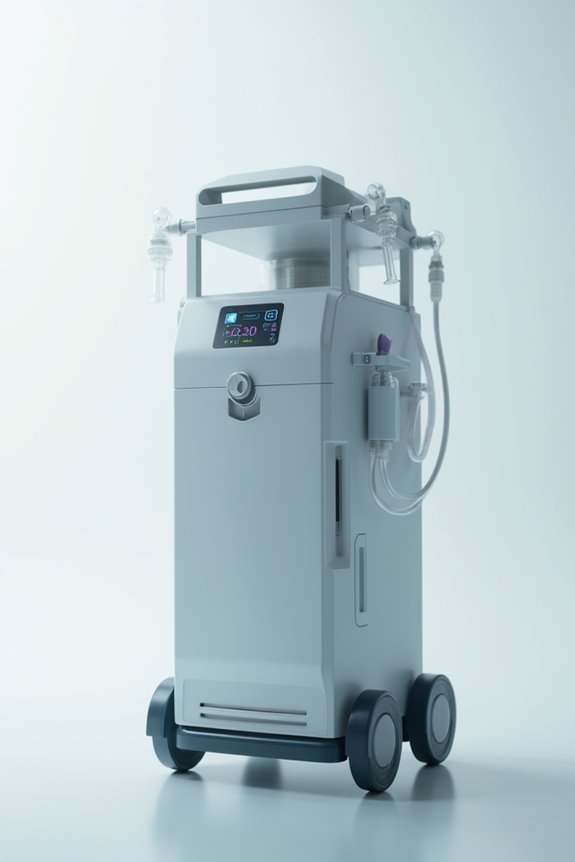
When choosing a mobile oxygen device, you’ll want to contemplate several key factors to guarantee it meets your needs. Focus on oxygen delivery capability, battery life, comfort, noise levels, and data tracking features. These elements can considerably impact your overall experience and effectiveness of the device.
Oxygen Delivery Capability
Oxygen delivery capability plays an essential role in selecting a mobile oxygen device tailored to individual health needs.
- Flow Rate: Typically measured in liters per minute (LPM), look for devices offering adjustable flow rates, such as 1-9L, to accommodate varying user requirements.
- Continuous Delivery: Continuous oxygen flow is vital for users needing stable oxygen levels, particularly during sleep or extended rest.
- Noise Level: Opt for devices with a noise level below 50 dB, enhancing comfort and minimizing disturbances.
- Personalized Monitoring: The ability to monitor and adjust oxygen concentration levels allows for customized therapy, improving health outcomes.
- Smart Features: Devices equipped with smart controls and timers facilitate better management of delivery, enhancing user-friendliness and effectiveness.
Battery Life and Duration
Battery life is a critical consideration in selecting a mobile oxygen device that meets your daily needs.
- Operation Duration: Devices like pulse oximeters provide 12-16 hours of continuous monitoring on a full charge. Make certain the duration aligns with your overnight or extended activity requirements.
- Battery Type: Look for rechargeable lithium batteries. These reduce frequent replacements, allowing for prolonged usage.
- Charging Time: Evaluate how quickly the device charges. Faster options enhance usability, especially for users needing quick recharges.
- Smart Notifications: Choose devices with alerts for low battery levels. This feature guarantees you can recharge before power runs out, maintaining stable oxygen delivery.
Comfort and Ergonomics
Choosing a mobile oxygen device with a focus on comfort and ergonomics is essential, as users may need to wear these devices for extended periods. Key considerations include:
- Lightweight Design: A lighter device reduces strain during prolonged use.
- Soft Materials: Fabrics that are gentle on the skin enhance overall comfort.
- Ergonomic Features: Look for adjustable straps and contouring sensors to guarantee a secure fit.
- User-Friendly Interface: Large screens and simple controls simplify operation, particularly for the elderly.
- Continuous Monitoring: Real-time tracking of oxygen levels allows adjustments based on personal comfort.
Selecting a device with these elements will optimize your experience and guarantee that you meet your oxygen needs effectively.
Noise Levels During Operation
When evaluating mobile oxygen devices, noise levels during operation are a critical aspect that can affect user comfort considerably.
- Decibel Ratings: Devices operate at noise levels ranging widely, with some as quiet as 48 dB.
- Impact on Sleep: Low noise operation is crucial for those requiring continuous therapy at night or in tranquil settings.
- Specifications Comparison: Examine noise specifications before purchasing to guarantee a peaceful atmosphere.
- Home Use Design: Devices targeted for residential use typically prioritize low noise to fit seamlessly into bedrooms and living rooms.
- Noise Tolerance: Understanding decibel ratings helps you select a device that aligns with your noise tolerance, enhancing overall satisfaction.
Choosing a device with ideal noise levels ultimately contributes to a more comfortable experience.
Data Tracking Features
Data tracking features play an essential role in selecting a mobile oxygen device, as they enhance the capabilities of monitoring and managing your health effectively.
Consider the following key aspects:
- Continuous Monitoring: Look for devices that track blood oxygen saturation (SpO2) and pulse rates continuously, recording data every second or four seconds.
- Built-in Memory: Confirm the device can store data from multiple sessions for easy future access.
- App Compatibility: Opt for models that provide graphical reports and allow data export in formats like PDF and CSV.
- Smart Notifications: Choose devices that alert you when levels drop below preset thresholds, promoting proactive health management.
- Easy Operation: Devices should activate automatically when worn and sync seamlessly with mobile apps for user-friendly experience.
User-Friendly Interface
A user-friendly interface is critical in mobile oxygen devices, impacting both the usability and effectiveness of these medical tools. Key features to evaluate include:
- Large screens with color LED displays for visibility of settings and readings.
- Remote control capabilities to adjust settings remotely, enhancing usability.
- Intuitive touch screens that minimize the learning curve for less tech-savvy users.
- Clear data management options, such as easy export of health reports in formats like PDF and CSV, improving tracking.
- Automatic activation when worn and minimal setup requirements support a seamless experience, particularly for elderly users or those with mobility challenges.
Choosing devices with these attributes can greatly enhance your oxygen therapy management.
Frequently Asked Questions
Are These Devices Suitable for Children or Only Adults?
The suitability of mobile oxygen devices for children is a critical concern.
- Age Considerations: Many devices are designed primarily for adult use.
- Weight: Confirm the device is lightweight enough for a child.
- Regulatory Approval: Check if the device is FDA-approved for pediatric use.
- Settings: Some units have adjustable settings which can accommodate children’s needs.
Evaluate these factors carefully before making a decision on usage for children.
How Often Should I Replace the Batteries in Mobile Oxygen Devices?
To guarantee peak performance, you should check your mobile oxygen device’s battery life regularly. Typically, most devices require battery replacement every 6 to 12 months, but this can vary based on usage and model.
Key Considerations:
- Usage Frequency: High usage may necessitate more frequent replacements.
- Battery Type: Lithium-ion batteries often last longer than alkaline.
- Manufacturer Recommendations: Always follow the specific guidelines provided by the manufacturer.
Can I Travel With These Devices on Airplanes?
Yes, you can travel with mobile oxygen devices on airplanes, but regulations apply. According to the FAA, about 30% of passengers require supplemental oxygen during flights.
Key Considerations:
- Notify the airline in advance.
- Carry a physician’s letter, detailing your needs.
- Verify the device meets airline specifications for size and battery life.
Complying with these guidelines will facilitate a smoother travel experience. Always check the airline’s specific requirements ahead of time.
Are Mobile Oxygen Devices Covered by Insurance?
Are mobile oxygen devices covered by insurance?
Many insurance plans cover portable oxygen devices, but this can vary widely. Factors influencing coverage include:
- Type of device: Fixed vs. portable
- Medical necessity: Documentation from a physician
- Provider network: In-network vs. out-of-network suppliers
To confirm, consult your insurance provider for specifics regarding coverage limits, co-pays, and prior authorization requirements. Always make sure to have proper prescriptions and follow your plan’s guidelines for reimbursement.
What Maintenance Do Portable Oxygen Devices Require?
When you’re relying on portable oxygen devices, think of them as tools in a well-maintained machine. Proper maintenance includes:
- Regular cleaning: Wipe down all surfaces with a damp cloth to prevent dust accumulation.
- Inspect components: Check tubing and connections for wear or damage weekly.
- Battery care: Charge batteries as recommended, avoiding overcharging.
- Annual servicing: Schedule professional maintenance to guarantee peak function.
Adhering to these guidelines helps guarantee your device operates efficiently.




